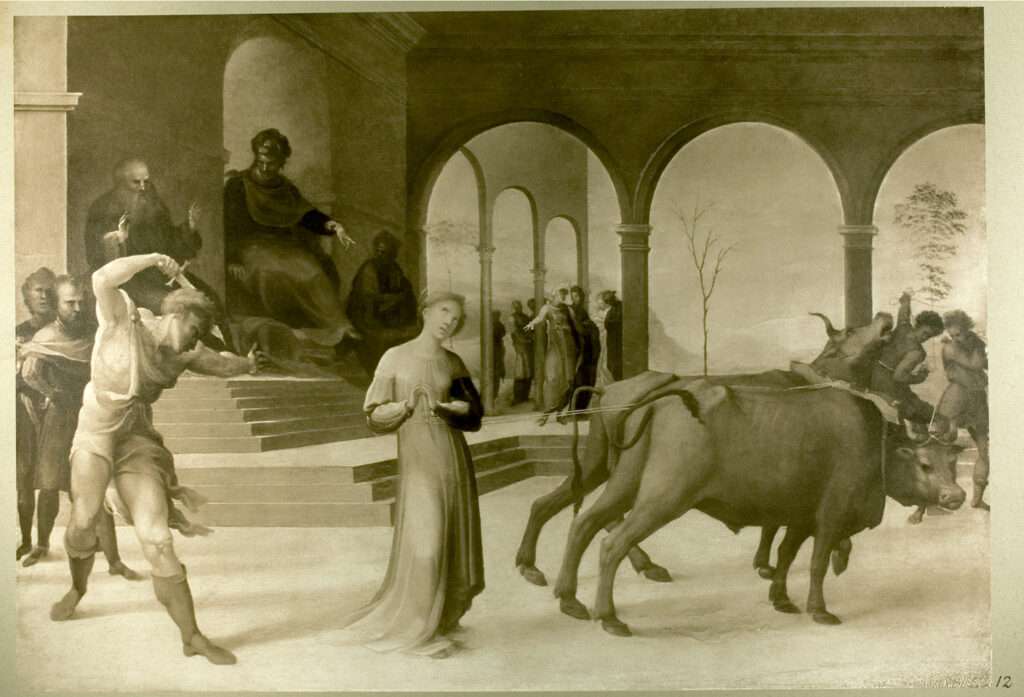Saint Lucy (in Latin Lucia, meaning “light”) was born between AD 281 and 283 in Syracuse, on the island of Sicily, then part of the Roman Empire. She was the only child of a noble and wealthy family. From a young age, she was raised in the Christian faith, living in a period marked by persecutions against Christians, especially during the reigns of Emperors Diocletian and Maximian, from the late 3rd to early 4th centuries.
Her Devotion and the Miracle of Her Mother
While still very young, Lucy took a vow of perpetual virginity, wishing to dedicate her entire life to Christ. However, her mother, Eutychia, had suffered for years from a chronic illness, often described as a continuous haemorrhage or a severe condition. Fearing death and leaving her daughter unprotected, Eutychia wished to see her married. To please her mother, Lucy accompanied her on a pilgrimage to the tomb of Saint Agatha, another Sicilian martyr, in the city of Catania.
While they prayed, Saint Agatha appeared to Lucy in a vision and said:
“Through your faith, your mother shall be healed. And just as I was the glory of Catania, you shall be the glory of Syracuse.”
Indeed, Eutychia was miraculously cured. After this miracle, Lucy decided to give her inheritance to the poor and devote herself entirely to God. This enraged the young man to whom she was betrothed, as he would lose both the dowry and social prestige. Furious, he denounced her to the Roman authorities for being a Christian — a grave crime at the time, since Christianity was seen as a threat to the state.

The Public Trial
Saint Lucy was brought before the governor of Sicily, named Pascasius (or Paschasius). The Roman tribunal judged her publicly because, at that time, Christianity was considered an act of high treason. Trials were public to serve as examples, intimidate other Christians, and assert imperial authority.
Before Pascasius, Lucy boldly declared:
“I am a servant of Christ. No force shall make me deny my Lord.”
Angry at her steadfastness, Pascasius tried to humiliate her by ordering that she be taken to a brothel, where she would be defiled and lose the purity she so treasured. At this point occurred one of the most famous miracles:
- Although bound and pulled by numerous soldiers, horses, and oxen, Lucy could not be moved from her place, remaining as immovable as a rock. No human force could drag her away. The crowd began murmuring that divine intervention was at work.
Tortures and Martyrdom
Seeing that he could not disgrace her, Pascasius ordered that she be burned alive, pouring boiling oil or resin over her body. Another miracle occurred: the fire did not consume her, and she continued to proclaim her faith aloud.
Finally, the governor decreed that she should be executed by the sword. Various traditions differ about her death:
- Some accounts state that she was beheaded.
- Others narrate that she was struck deeply with a sword to the neck or abdomen, yet survived for some time. Even while dying, she reportedly prophesied the death of Emperor Diocletian and the end of the persecutions against Christians.
Saint Lucy died a martyr on 13 December AD 304, at the age of about 20 or 21.
The Tradition of Her Eyes
A popular tradition (although not historically verified) recounts that Saint Lucy had her eyes gouged out during torture, or that she herself removed them to repel suitors captivated by her beauty. Hence her strong association with sight and the eyes.
For this reason, she is often depicted in icons and images holding a plate or tray with her eyes, symbolising not merely physical vision but the light of faith that illuminates the soul.
Miracles Attributed to Saint Lucy
- Miraculous healing of her mother, Eutychia.
- Supernatural immobility when they tried to drag her to the brothel.
- Protection from fire, which did not burn her.
- Numerous cures of eye diseases over the centuries, attributed to her intercession.
Relics of Saint Lucy
After her martyrdom, Lucy’s body was initially buried in Syracuse, which soon became a place of pilgrimage. However, over the centuries, her relics underwent several transfers due to invasions and wars.
- Syracuse: Holds relics in the Basilica of Santa Lucia extra moenia (“outside the walls” of the city).
- Venice: A significant portion of her relics was transferred there to protect them from Saracen invasions. They remained for a long time in the Church of Santa Lucia (next to the train station bearing her name), later moved to the Church of San Geremia, where they are still kept today.
- Smaller relics are preserved in Metz (France) and in other churches across Europe.
The body of Saint Lucy, in Venice, rests in a glass urn, visible to the faithful.
Cult and Feast Day
Saint Lucy is celebrated on 13 December, a date close to the winter solstice in the Northern Hemisphere. For this reason, her cult became associated with the idea of light triumphing over darkness.
In countries such as Sweden, Norway, and Finland, beautiful processions are held in her honour, with girls dressed in white wearing crowns of lit candles, symbolising the arrival of light in the dark winter.
Saint Lucy in the Orthodox Church
Yes, Saint Lucy is also venerated in the Orthodox Church, especially in the Byzantine and Greek traditions. There she is known as:
- Ἁγία Λουκία ἡ Παρθενομάρτυς (Hagia Lucia, the virgin martyr)
Her feast is usually celebrated on 13 December, whether according to the Julian or Gregorian calendar, depending on local tradition. Her name appears in Orthodox Synaxaria (the equivalent of the Roman Martyrology). She is especially invoked as the protector against eye diseases and as a symbol of spiritual light.
Although her cult is stronger in the West, Orthodox icons depicting her and prayers seeking her intercession do exist.
Of What Is Saint Lucy the Patroness?
- Patroness of eyes, vision, and eye diseases.
- Protector against physical and spiritual blindness.
- Patroness of ophthalmologists.
- Patroness of the city of Syracuse, her native city.
- Symbol of the light of faith.
- Invoked by those seeking spiritual clarity or healing of their eyes.
Saint Lucy, pray for us, that we may always have the light of faith and the health of our eyes!
See the stories of other saints of the Catholic Church
References
- DE VARAZZE, Jacopo. Legenda Áurea: vida dos santos. São Paulo: Companhia das Letras, 2003.
- MARTYROLOGIUM ROMANUM. Martyrologium Romanum ex decreto Sacrosancti Concilii Oecumenici Vaticani II instauratum auctoritate Pauli PP. VI promulgatum. Typis Polyglottis Vaticanis, 2004.
- ACTA SANCTORUM. Acta Sanctorum Decembris, Tomus II. Paris: Société des Bollandistes, 1850.
- DEL COL, Laura. Santa Lucia: storia, culto e tradizioni. Roma: Edizioni Paoline, 2012.
- HALL, James. Dictionary of Subjects and Symbols in Art. New York: Harper & Row, 1974.
- SINAXÁRIO DA IGREJA ORTODOXA. Synaxarion of the Orthodox Church. Thessaloniki: Apostoliki Diakonia, 1998.
- HOLWECK, Frederick. “Lucia of Syracuse” in Catholic Encyclopedia, New York: Robert Appleton Company, 1910. Available at: https://www.newadvent.org/cathen/09414a.htm. Accessed on: 28 June 2025.
- CAVALLERO, Giovanni. Santa Lucia: tra storia e leggenda. Venezia: Marsilio Editori, 1995.
